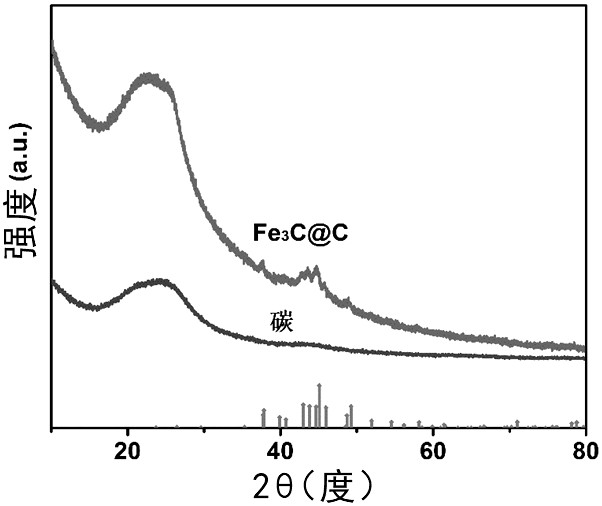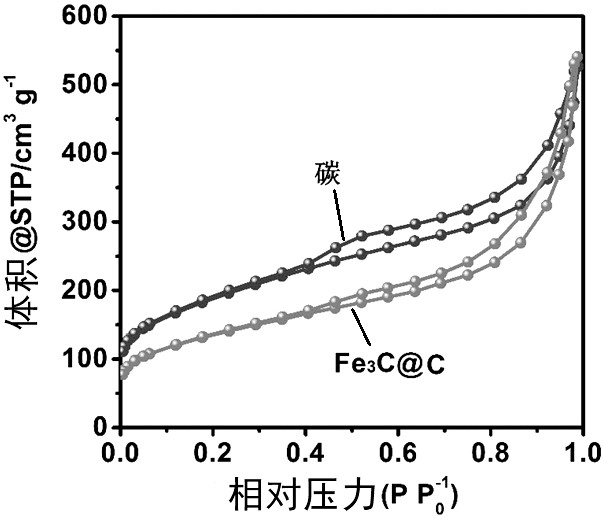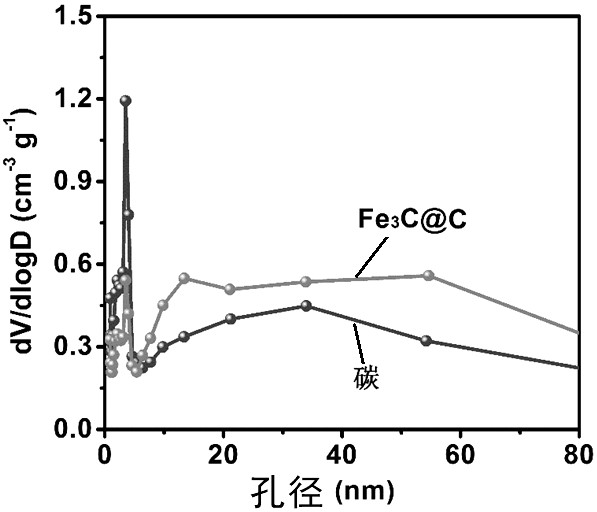Preparation method of positive electrode of lithium-sulfur battery
A lithium-sulfur battery and positive electrode technology, which is applied in the field of lithium-sulfur battery positive electrode preparation, can solve the problems of polysulfide shuttle, lithium-sulfur battery capacity attenuation, and reduce reactive sites, etc., to achieve rapid lithium ion diffusion and electron transport, Achieve stable operation and broaden the range of use
- Summary
- Abstract
- Description
- Claims
- Application Information
AI Technical Summary
Problems solved by technology
Method used
Image
Examples
Embodiment 1
[0050] Step 1: Fe for low temperature and high areal capacity lithium-sulfur batteries 3 Preparation of C@C composites
[0051] (1) Mix 5g urea, 0.02 mol / L Fe(NO 3 ) 3 9H 2 0 and 160 mg surfactant F127 were stirred and dissolved in 10 mL deionized water to obtain mixed solution A;
[0052] (2) Dissolve 0.25 g of glucosamine hydrochloride, 3.35 mL of silica gel and 540 µL of 0.5 M dilute sulfuric acid solution in 2 mL of deionized water, and stir to obtain mixed solution B;
[0053] (3) Slowly add the mixed solution B to the mixed solution A, and stir at room temperature to obtain the mixed solution C;
[0054] (4) Freeze-dry the above mixed solution C for 48 h;
[0055] (5) The sample obtained after freeze-drying was carbonized in a tube furnace under a nitrogen atmosphere. First, the temperature was raised to 500 °C at a rate of 5 °C / min and kept for 2 h, and then the temperature was raised to 900 °C at a rate of 5 °C / min. , keep warm for 2h;
[0056] (6) Cool to room ...
Embodiment 2
[0075] Step 1: Fe for low temperature and high areal capacity lithium-sulfur batteries 3 Preparation of C@C composites
[0076] (1) Mix 10g urea, 0.04 mol / L Fe(NO 3 ) 3 9H 2 0 and 160 mg surfactant F127 were stirred and dissolved in 20 mL deionized water to obtain mixed solution A;
[0077](2) Dissolve 0.5 g of glucosamine hydrochloride, 5 mL of silica gel and 540 µL of 0.5 M dilute sulfuric acid solution in 2 mL of deionized water, and stir to obtain mixed solution B;
[0078] (3) Slowly add the mixed solution B to the mixed solution A, and stir at room temperature to obtain the mixed solution C;
[0079] (4) Freeze-dry the above mixed solution C for 48 h;
[0080] (5) The sample obtained after freeze-drying was carbonized in a tube furnace under a nitrogen atmosphere. First, the temperature was raised to 500 °C at a rate of 5 °C / min and kept for 2 h, and then the temperature was raised to 900 °C at a rate of 5 °C / min. , keep warm for 2h;
[0081] (6) Cool to room temp...
PUM
 Login to View More
Login to View More Abstract
Description
Claims
Application Information
 Login to View More
Login to View More - R&D
- Intellectual Property
- Life Sciences
- Materials
- Tech Scout
- Unparalleled Data Quality
- Higher Quality Content
- 60% Fewer Hallucinations
Browse by: Latest US Patents, China's latest patents, Technical Efficacy Thesaurus, Application Domain, Technology Topic, Popular Technical Reports.
© 2025 PatSnap. All rights reserved.Legal|Privacy policy|Modern Slavery Act Transparency Statement|Sitemap|About US| Contact US: help@patsnap.com



